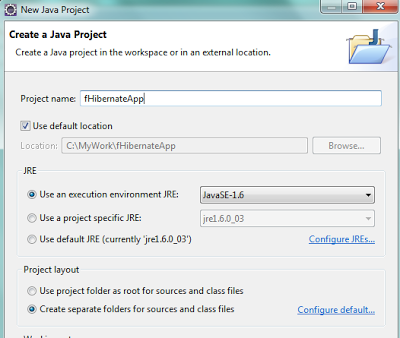Hibernate is Object Relational mapping (ORM) tool which is open source and distributed under the GNU Lesser General Public License.
It is mainly used to map the class object with the relational database.It also Provides data query and data retrieval functionality.
In hibernate database schema is maintained by either xml file or using Annotations.
Project View After Completion :
File > New > Project > Java Project > click next
again Click next > Finish
In pop up window Open Associative Perspective , Select No.
Hibernate Environment Setting
Right click over project on Project Explorer and go-to properties > Java Build Path > Libraries
Add Required Hibernate jars, JRE system Library, Apache Tomcat server by click on Add Library and Add External Jar ojdbc14.jar by click on Add External Jars.
For Details Read How to set Hibernate Environment
Create Configuration file
Right click over Project's src folder
New->File
Click next and write configuration file name then click finish
Create Model Class
Right click over src folder
New > class
click finish.
hibernate.cfg.xml
This is a file that contains information about Oracle database(or any other database you want to use) Driver and connection information and mapping class information.
We can also use create property in place of update. create is a property which drops the table if it already in database and creates new one but update makes the changes in the table if its already there and if table is not there then creates a new one.
Student.java
This is a POJO class and it is working as Persistent class for Hibernate and the same java class we are using to store object of Student class using Hibernate Framework.
we are also using Annotations such as @Entity,@table,@Id etc.
If you want to give class name as a table name then remove @Table code from below code.
If we don't use Hibernate Annotations in our project then we have to create mapping file(.hbm file)
Annotation @GeneratedValue uses different types are following:
To Generate Getters and Setters Right Click inside Student.java then select Source > Generate Getters and Setters
To Run this Project Right Click inside Student.java, select Run As > Java Application
Download Code Link 1
Download Code Link 2
Output:
More Hibernate Topics :
It is mainly used to map the class object with the relational database.It also Provides data query and data retrieval functionality.
In hibernate database schema is maintained by either xml file or using Annotations.
Project View After Completion :
File > New > Project > Java Project > click next
again Click next > Finish
In pop up window Open Associative Perspective , Select No.
Hibernate Environment Setting
Right click over project on Project Explorer and go-to properties > Java Build Path > Libraries
Add Required Hibernate jars, JRE system Library, Apache Tomcat server by click on Add Library and Add External Jar ojdbc14.jar by click on Add External Jars.
For Details Read How to set Hibernate Environment
Create Configuration file
Right click over Project's src folder
New->File
Click next and write configuration file name then click finish
Create Model Class
Right click over src folder
New > class
click finish.
hibernate.cfg.xml
This is a file that contains information about Oracle database(or any other database you want to use) Driver and connection information and mapping class information.
We can also use create property in place of update. create is a property which drops the table if it already in database and creates new one but update makes the changes in the table if its already there and if table is not there then creates a new one.
<?xml version="1.0" encoding="UTF-8"?>
<!DOCTYPE hibernate-configuration PUBLIC "-//Hibernate/Hibernate Configuration DTD 3.0//EN" "http://hibernate.sourceforge.net/hibernate-configuration-3.0.dtd">
<hibernate-configuration>
<session-factory>
<property name="hibernate.dialect">org.hibernate.dialect.OracleDialect</property>
<property name="hibernate.connection.driver_class">oracle.jdbc.OracleDriver</property>
<property name="hibernate.connection.url">jdbc:oracle:thin:@localhost:1521:xe</property>
<property name="hibernate.connection.username">hr</property>
<property name="hibernate.connection.password">hr</property>
<property name="hibernate.show_sql">true</property>
<property name="hibernate.hbm2ddl.auto">update</property>
<mapping class="blog.webideaworld.in.Student"/>
</session-factory>
</hibernate-configuration>
Student.java
This is a POJO class and it is working as Persistent class for Hibernate and the same java class we are using to store object of Student class using Hibernate Framework.
we are also using Annotations such as @Entity,@table,@Id etc.
If you want to give class name as a table name then remove @Table code from below code.
If we don't use Hibernate Annotations in our project then we have to create mapping file(.hbm file)
package blog.webideaworld.in;
import javax.persistence.Entity;
import javax.persistence.GeneratedValue;
import javax.persistence.Id;
import javax.persistence.Table;
import org.hibernate.Session;
import org.hibernate.SessionFactory;
import org.hibernate.cfg.Configuration;
@Entity
@Table(name="MyStudent")
public class Student {
@Id
@GeneratedValue
private int id;
private String name;
private int rollno;
public int getId() {
return id;
}
public void setId(int id) {
this.id = id;
}
public String getName() {
return name;
}
public void setName(String name) {
this.name = name;
}
public int getRollno() {
return rollno;
}
public void setRollno(int rollno) {
this.rollno = rollno;
}
public static void main(String args[]){
Student st =new Student();
st.setName("jack");
st.setRollno(44);
@SuppressWarnings("deprecation")
SessionFactory sessionFactory =new Configuration().configure("hibernate.cfg.xml").buildSessionFactory();
Session session=sessionFactory.openSession();
session.beginTransaction();
session.save(st);
session.getTransaction().commit();
}
}
Annotation @GeneratedValue uses different types are following:
To Generate Getters and Setters Right Click inside Student.java then select Source > Generate Getters and Setters
To Run this Project Right Click inside Student.java, select Run As > Java Application
Download Code Link 1
Download Code Link 2
Output:
More Hibernate Topics :
- How to Set Hibernate Environment for Eclipse with Oracle 10g Express Edition
- Basic Hibernate Application with Annotations
- Basic Hibernate Application with hibernate mapping (hbm.xml) file
- Hibernate OneToOne Mapping with Annotations
- Hibernate one-to-one Mapping with Hibernate Mapping (hbm.xml) file
- Hibernate OneToMany Mapping with Annotations
- Hibernate one-to-many Mapping with Hibernate Mapping (hbm.xml) file
- Hibernate ManyToOne Mapping with Annotations
- Hibernate many-to-one Mapping with Hibernate Mapping (hbm.xml) file
- Hibernate mappedBy and ManyToMany Mapping with Annotations
- Hibernate many-to-many Mapping with Hibernate Mapping (hbm.xml) file
- Hibernate OneToMany Mapping with CascadeType and other Annotations









No comments:
Post a Comment